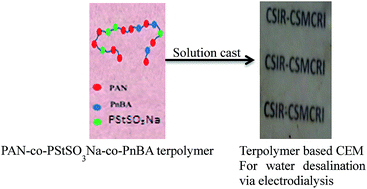Poly(acrylonitrile-co-styrene sodium sulfonate-co-n-butyl acrylate) terpolymer based cation exchange membrane for water desalination via electrodialysis†
Abstract
A process for the preparation of cation exchange membranes (CEMs) by avoiding the commonly used post sulfonation reaction of aromatic rings is reported. Films were fabricated from terpolymers of polyacrylonitrile (PAN), polystyrene sodium sulfonate (PStSO3Na) and polyn-butyl acrylate (PnBA) for use as CEMs for water desalination via electrodialysis. Initially, efforts were directed to obtain CEMs with suitable mechanical properties and stability in aqueous medium by adjusting the terpolymer composition. Terpolymer composition was adjusted by optimizing the AN : StSO3Na : nBA (w/w) ratio in the copolymerization feed. The terpolymer synthesized by the copolymerization of 75% (w/w) AN, 15% (w/w) StSO3Na and 10% (w/w) nBA in the feed mixture yielded a CEM (containing 31.7% w/w PStSO3Na) which exhibited 8.7 MPa tensile stress and 34% strain at rupture under water wet state and is suitable for use in an electrodialysis unit. This CEM also shows 1.50 meq. g−1 ion exchange capacity, 1.37 mS cm−1 ionic conductivity and 0.87 transport number. The power consumption and current efficiency of the membrane were 1.06 kW h kg−1 and 86% respectively at an applied potential of 2 volt/cell pair during desalination of diluted sea water (total dissolved solid 2000 mg L−1). The CEM was stable at pH range 3–12 and temperature up to 70 °C and also exhibited stability even after exposure to Fenton's reagent at 70 °C for 9 h.


 Please wait while we load your content...
Please wait while we load your content...